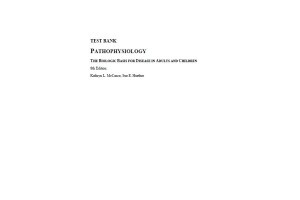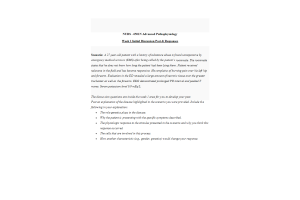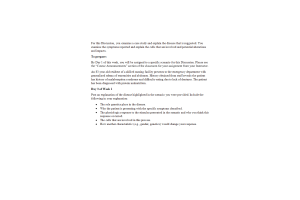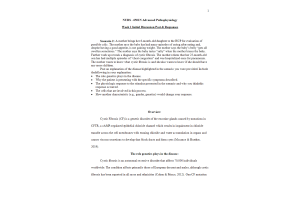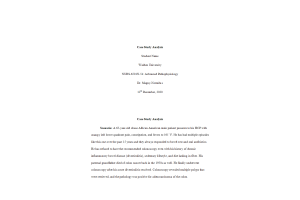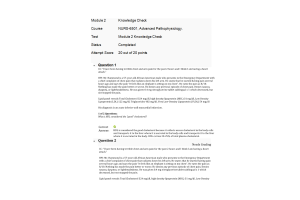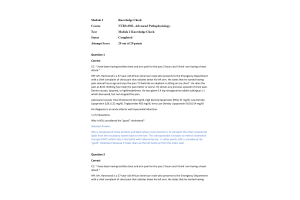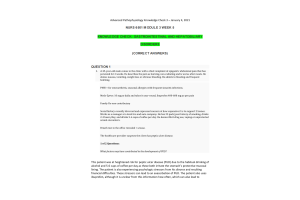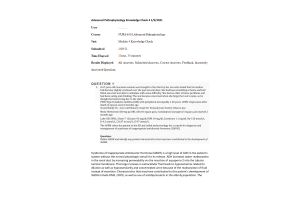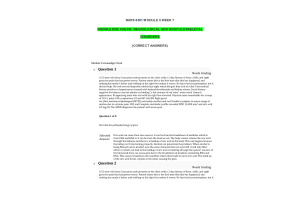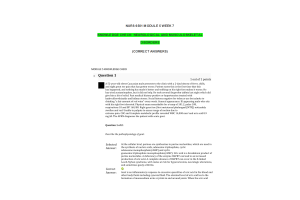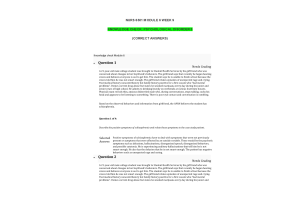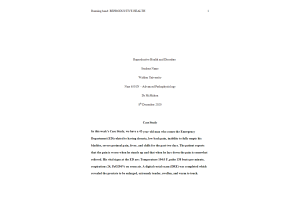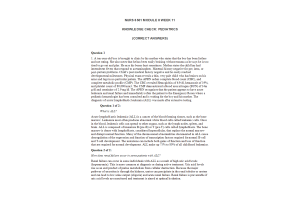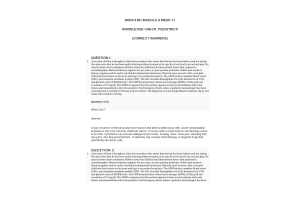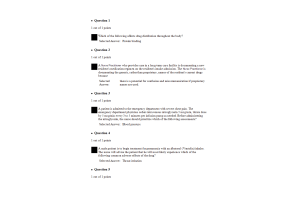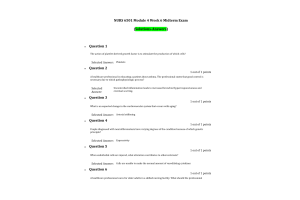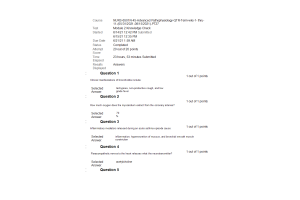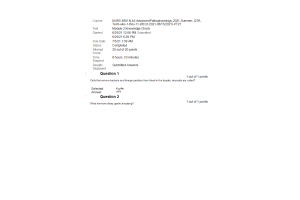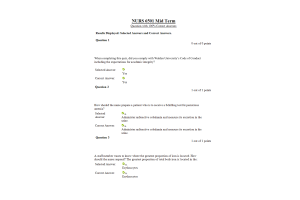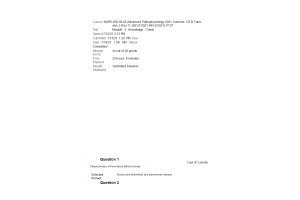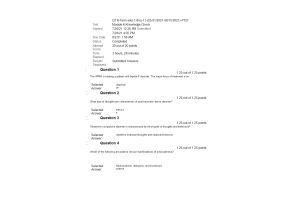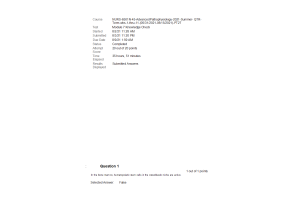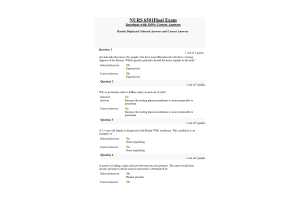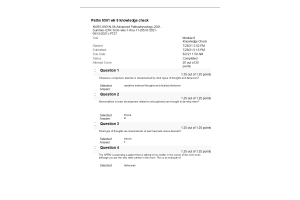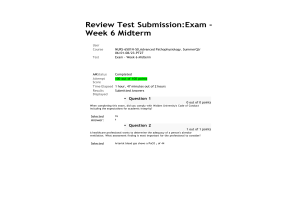NURS 6501 Week 10 Knowledge Check; Womens and Mens Health, Infections, and Hematologic
- $25.00
- Question: A 28-year-old woman presents to the clinic with a chief complaint of hirsutism and irregular menses. She describes irregular and infrequent menses (five or six per year) since menarche at 12 years of age. She began to develop dark, coarse facial hair when she was 14 years of age, but her parents did not seek treatment or medical opinion at that time. The symptoms worsened after she gained weight in college. She got married 3 years ago and has been trying to get pregnant for the last 2 years without success. Height 66 inches and weight 198. BMI 32 kg.m2. Moderate hirsutism without virilization noted. Laboratory data reveal CMP within normal limits (WNL), CBC with manual differential (WNL), TSH 0.9 IU/L SI units (normal 0.4-4.0 IU/L SI units), a total testosterone of 65 ng/dl (normal 2.4-47 ng/dl), and glycated hemoglobin level of 6.1% (normal value ≤5.6%). Based on this information, the APRN diagnoses the patient with polycystic ovarian syndrome (PCOS) and refers her to the Women’s Health APRN for further workup and management.
- Question: A 28-year-old woman presents to the clinic with a chief complaint of hirsutism and irregular menses. She describes irregular and infrequent menses (five or six per year) since menarche at 12 years of age. She began to develop dark, coarse facial hair when she was 14 years of age, but her parents did not seek treatment or medical opinion at that time. The symptoms worsened after she gained weight in college. She got married 3 years ago and has been trying to get pregnant for the last 2 years without success. Height 66 inches and weight 198. BMI 32 kg.m2. Moderate hirsutism without virilization noted. Laboratory data reveal CMP within normal limits (WNL), CBC with manual differential (WNL), TSH 0.9 IU/L SI units (normal 0.4-4.0 IU/L SI units), a total testosterone of 65 ng/dl (normal 2.4-47 ng/dl), and glycated hemoglobin level of 6.1% (normal value ≤5.6%). Based on this information, the APRN diagnoses the patient with polycystic ovarian syndrome (PCOS) and refers her to the Women’s Health APRN for further workup and management.
- Question: A 20-year-old female college student presents to the Student Health Clinic with a chief complaint of abdominal pain, foul smelling vaginal discharge, and fever and chills for the past 4 days. She denies nausea, vomiting, or difficulties with defecation. Last bowel movement this morning and was normal for her. Nothing has helped with the pain despite taking ibuprofen 200 mg orally several times a day. She describes the pain as sharp and localizes the pain to her lower abdomen. Past medical history noncontributory. GYN/Social history + for having had unprotected sex while at a fraternity party. Physical exam: thin, Ill appearing anxious looking white female who is moving around on the exam table and unable to find a comfortable position. Temperature 101.6F orally, pulse 120, respirations 22 and regular. Review of systems negative except for chief complaint. Focused assessment of abdomen demonstrated moderate pain to palpation left and right lower quadrants. Upper quadrants soft and non-tender. Bowel sounds diminished in bilateral lower quadrants. Pelvic exam demonstrated + adnexal tenderness, + cervical motion tenderness and copious amounts of greenish thick secretions. The APRN diagnoses the patient as having pelvic inflammatory disease (PID).
- Question: A 27-year-old male comes to the clinic with a chief complaint of a “sore on my penis” that has been there for 3 days. He says it burns and leaked a little fluid. He denies any other symptoms. Past medical history noncontributory. Social history: works as a bartender and he states he often “hooks up” with some of the patrons, both male and female after work. He does not always use condoms. Physical exam within normal limits except for a lesion on the lateral side of the penis adjacent to the glans. The area is indurated with a small round raised lesion. The APRN orders laboratory tests, but feels the patient has syphilis.
- Question: A 19-year-old female presents to the clinic with a chief complaint of “fluid filled bumps” and intense pruritis of her vulva. She states these symptoms have been present for about 10 days, but she thought she had a yeast infection. She self-medicated with over the counter (OTC) metronidazole (Flagyl™) intravaginally but the symptoms got worse. No other complaints except for fatigue out of proportion to her activity level. Past medical history noncontributory. Social history: sexually active with several men and did forget to use a condom during one sexual encounter. Physical exam negative except for pelvic exam which revealed multiple fluid filled (vesicular) lesions on the vulva and introitus. Positive lymph nodes in inguinal areas. The APRN diagnoses the patient with herpes simplex virus-type 2 known as genital herpes.
- Question: A 27-year-old male presents to the clinic with a chief complaint of a gradual onset of scrotal pain and swelling of the left testicle that started 2 days ago. The pain has gotten progressively worse over the last 12 hours and he now complains of left flank pain. He complains of dysuria, frequency, and urgency with urination. He states his urine smells funny. He denies nausea, vomiting, but admits to urethral discharge just prior to the start of his severe symptoms. He denies any recent heavy lifting or straining for bowel movements. He says the only thing that makes the pain better is if he sits in his recliner and elevates his scrotum on a small pillow. Past medical history negative. Social history + for sexual activity only with his wife of 3 years. Physical exam reveals red, swollen left testicle that is very tender to touch. There is positive left inguinal adenopathy. Clean catch urinalysis in the clinic + for 3+ bacteria. The APRN diagnoses the patient with epididymitis.
- Question: A 42-year-old male presents to the clinic with a chief complaint of fever, chills, malaise, arthralgias, dysuria, urinary frequency, low back pain, perineal, and suprapubic pain. He says he feels like he can’t fully empty his bladder when he voids. He states these symptoms came on suddenly about 12 hours ago and have gotten worse. He noticed some blood in his urine the last time he voided. He tried to have a bowel movement several hours ago but could not empty his bowel due to pain. Past medical and social history noncontributory. Physical exam reveals an ill appearing male. Temperature 101.8 F, pulse 122, respirations 20, BP 108/68. Exam unremarkable apart from left costovertebral angle (CVA) tenderness. Rectal exam difficult due to enlarged and extremely painful prostate. Complete blood count revealed an elevated white blood cell count, elevated C-reactive protein and elevated sedimentation rate. Urine dip in the clinic + for 2+ bacteria.
- Question: A 32-year-old woman presents to the clinic with a chief complaint of pelvic pain, excessive menstrual bleeding, dyspareunia, and inability to become pregnant after 18 months of unprotected sex with her husband. She states she was told she had endometrioses after a high school physical exam, but no doctor or nurse practitioner ever mentioned it again, so she thought it had gone away. She has no other complaints and says she wants to have a family. Past medical history noncontributory except for possible endometriosis as a teenager. Social history negative for tobacco, drugs or alcohol. The physical exam is negative except for the pelvic exam which demonstrated pain on light and deep palpation of the uterus. The APRN believes that the patient does have endometriosis and orders appropriate laboratory and radiological tests. The diagnostics come back highly suggestive of endometriosis.
- Question: An APRN working in an anticoagulation clinic has been asked by the local college to present a lecture on platelets and their role in blood clotting to the graduate pathophysiology nursing students.
- Question: A 36-year-old woman presents to the clinic with complaints of dyspnea on exertion, fatigue, leg cramps on climbing stairs, craving ice to suck or chew and cold intolerance. The symptoms have come on gradually over the past 4 months. The only thing that make the symptoms better is for her to sit or lie down and stop the activity. She denies bruising or bleeding and states this is the first time this has happened. Past medical history noncontributory except for a new diagnosis of benign uterine fibroids 6 months ago after experiencing heavy menstrual bleeding every month. Social history noncontributory and she denies alcohol, tobacco, or drug use. Physical exam: pale, thin, Caucasian female who appears older than stated age. Physical exam remarkable for a soft I/IV systolic murmur, pallor of the mucous membranes, spoon-shaped nails (koilonychia), glossy tongue, with atrophy of the lingual papillae, and fissures at the corners of the mouth. The APRN suspects the patient has iron deficient anemia (IDA) secondary to excessive blood loss from uterine fibroids. The appropriate laboratory tests confirmed the diagnosis.
- Question: A 67-year-old woman presents to the clinic with complaints of weakness, fatigue, paresthesias of the feet and fingers, difficulty walking, loss of appetite, and a sore tongue. These symptoms have been present for several months but the patient thought they were due to her recent retirement and geographic move from the Midwest to New England. The symptoms have gotten worse over the past few weeks and she has noticed that she is much more forgetful. This is of great concern as she worries she might have the beginning stages of Alzheimer’s Disease. Past medical history significant for Hashimoto thyroiditis that she developed in her early 20s. The rest of PMH and social history non- contributory. Physical exam reveals an average sized female whose skin has a sallow appearance. BP 128/74, Pulse 120, respirations 18 and temperature 99.0F orally. Examination of the head and neck reveals a smooth and beefy red tongue. Abdominal exam negative for hepatomegaly or splenomegaly.
- Question: A 67-year-old woman presents to the clinic with complaints of weakness, fatigue, paresthesias of the feet and fingers, difficulty walking, loss of appetite, and a sore tongue. These symptoms have been present for several months but the patient thought they were due to her recent retirement and geographic move from the Midwest to New England. The symptoms have gotten worse over the past few weeks and she has noticed that she is much more forgetful. This is of great concern as she worries she might have the beginning stages of Alzheimer’s Disease. Past medical history significant for Hashimoto thyroiditis that she developed in her early 20s. The rest of PMH and social history non- contributory. Physical exam reveals an average sized female whose skin has a sallow appearance. BP 128/74, Pulse 120, respirations 18 and temperature 99.0F orally. Examination of the head and neck reveals a smooth and beefy red tongue. Abdominal exam negative for hepatomegaly or splenomegaly.
- Question: A 49-year-old man with a 22-year history of severe rheumatoid arthritis (RA) presents to clinic for his preadmission testing (PAT) and medical clearance for a planned right total hip arthroplasty. The patient had been severely limited in ambulation due to the RA. Current medications include prednisone 20 mg poqd and methotrexate 7.5 mg Thursdays, 5mg Fridays, and 7.5 mg Saturdays. The patient had a complete blood count (CBC) with manual differentiation and red blood cell indices, complete metabolic panel (CMP) and coagulation studies (prothrombin time [PT], international normalized ratio [INR] and activated partial thromboplastin time [aPTT]). All the laboratory studies come back within normal limits except for the red blood cell indices. The hemoglobin and hematocrit were low along with mean corpuscle volume, plasma iron and total iron binding capacity, and transferrin also being low. There was a normal reticulocyte count, normal ferritin, serum B12, folate and bilirubin.
- Question: A 49-year-old man with a 22-year history of severe rheumatoid arthritis (RA) presents to clinic for his preadmission testing (PAT) and medical clearance for a planned right total hip arthroplasty. The patient had been severely limited in ambulation due to the RA. Current medications include prednisone 20 mg poqd and methotrexate 7.5 mg Thursdays, 5mg Fridays, and 7.5 mg Saturdays. The patient had a complete blood count (CBC) with manual differentiation and red blood cell indices, complete metabolic panel (CMP) and coagulation studies (prothrombin time [PT], international normalized ratio [INR] and activated partial thromboplastin time [aPTT]). All the laboratory studies come back within normal limits except for the red blood cell indices. The hemoglobin and hematocrit were low along with mean corpuscle volume, plasma iron and total iron binding capacity, and transferrin also being low. There was a normal reticulocyte count, normal ferritin, serum B12, folate and bilirubin.
- Question: A 14-year-old female is brought to the Urgent Care by her mother who states that the girl has had an abnormal number of bruises and “funny looking red splotches” on her legs. These bruises were first noticed about 2 weeks ago and are not related to trauma. Past medical history not remarkable and she takes no medications. The mother does state the girl is recovering from a “bad case of mono” and was on bedrest at home for the past 3 weeks. The girl noticed that her gums were slightly bleeding when she brushed her teeth that morning.
- Question: A 22-year-old male is in the Surgical Intensive Care Unit (SICU) following a motor vehicle crash (MVC) where he sustained multiple life-threatening injuries including a torn aorta, ruptured spleen, and bilateral femur fractures. He has had difficulty maintaining his mean arterial pressure (MAP) and has required various vasopressors. He has a triple lumen central venous catheter (CVC) for monitoring his central venous pressure, administration of medications and blood products, as well as total parenteral nutrition. Per hospital protocol, he is receiving an unfractionated heparin 1:1000 flush after administration of each of the triple antibiotics that have been ordered to maintain patency of the lumens. Seven days post injury, the APRN in the SICU is reviewing the patient’s morning labs and notes that his platelet count has dropped precipitously to 50,000 /mm3 from 148,000/mm3 two days ago. The APRN suspects the patient is developing heparin induced thrombocytopenia (HIT).
- Question: A 22-year-old male is in the Surgical Intensive Care Unit (SICU) following a motor vehicle crash (MVC) where he sustained multiple life-threatening injuries including a torn aorta, ruptured spleen, and bilateral femur fractures. He has had difficulty maintaining his mean arterial pressure (MAP) and has required various vasopressors. He has a triple lumen central venous catheter (CVC) for monitoring his central venous pressure, administration of medications and blood products, as well as total parenteral nutrition. Per hospital protocol, he is receiving an unfractionated heparin 1:1000 flush after administration of each of the triple antibiotics that have been ordered to maintain patency of the lumens. Seven days post injury, the APRN in the SICU is reviewing the patient’s morning labs and notes that his platelet count has dropped precipitously to 50,000 /mm3 from 148,000/mm3 two days ago. The APRN suspects the patient is developing heparin induced thrombocytopenia (HIT).
- Question: A 33-year-old female is brought to Urgent Care by her husband who states his wife has gotten suddenly confused and complains of a severe headache. He also noticed large bruises on her legs which were not there yesterday. Only significant past medical history is that the patient developed herpes zoster 2 weeks ago and was given acyclovir for treatment. Physical exam revealed well developed female who is only oriented to person. Large areas of ecchymosis noted on both arms and legs. Stat CBC revealed a platelet count of 18,000/mm3, hemoglobin of 8 g/dl and hematocrit of 24%. The patient was immediately transported to the Emergency Room by Emergency Medical Services (EMS) where further work up demonstrated idiopathic thrombotic thrombocytopenic purpura (TTP).
- Question: A 64-year man is recovering from a transurethral resection of the prostate for treatment of benign prostate hyperplasia. The patient is receiving intravenous antibiotics for the urinary tract infection that was found on the preoperative urine culture and sensitivity (C & S). The post-operative course has been smooth and the APRN is removing the 3-way Foley catheter when there is a sudden release of bright red blood with many blood clots in the Foley bag. The patient becomes hypotensive, tachycardic and the APRN notes new ecchymoses on the patient’s arms and legs. The patient was immediately transferred to the surgical intensive care unit (SICU) and a stat hematology consult was conducted. Stat CBC, d-dimer, peripheral blood smear, partial thromboplastin time, Prothrombin time/international normalization ratio (INR), and fibrinogen labs were drawn. Results were:
- Question: A 64-year man is recovering from a transurethral resection of the prostate for treatment of benign prostate hyperplasia. The patient is receiving intravenous antibiotics for the urinary tract infection that was found on the preoperative urine culture and sensitivity (C & S). The post-operative course has been smooth and the APRN is removing the 3-way Foley catheter when there is a sudden release of bright red blood with many blood clots in the Foley bag. The patient becomes hypotensive, tachycardic and the APRN notes new ecchymoses on the patient’s arms and legs. The patient was immediately transferred to the surgical intensive care unit (SICU) and a stat hematology consult was conducted. Stat CBC, d-dimer, peripheral blood smear, partial thromboplastin time, Prothrombin time/international normalization ratio (INR), and fibrinogen labs were drawn. Results were:

